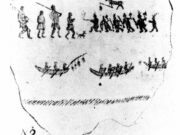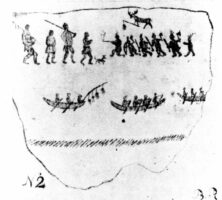A controversial Creek Indian leader in the 1780s and 1790s, Alexander McGillivray was one of many Southeastern Indians with a Native American mother and European father. He played off European powers to protect Creek interests, initiated nationalist reforms within Creek society, and used trade to increase his own position on the southern frontier.
McGillivray was born probably in 1750 in Little Tallassee near present-day Montgomery, Alabama. The son of Scottish trader Lachlan McGillivray and a Creek woman named Sehoy, McGillivray grew up in matrilineal Creek society as a full member of his mother’s Wind Clan. In addition to learning the unwritten rules and expectations of Native American society, McGillivray also became comfortable in the colonial society of his father. Before returning to Creek society in 1777, he had lived in Augusta, received a European-style education in Charleston, South Carolina, and held a business apprenticeship in Savannah.
At the start of the American Revolution (1775-83) McGillivray permanently returned to Little Tallassee and Creek society when the revolutionaries confiscated his Tory father’s property in South Carolina. Upon his return to the Creeks McGillivray discovered that his linguistic ability and understanding of Creek and colonial societies allowed him to take on increasingly important roles. During the war he held a commission as a colonel in the British army, worked for British Superintendent of Indian Affairs John Stuart, as well as Stuart’s successor, Thomas Brown, and orchestrated alliances between Creek and British forces.
McGillivray embodied many of the wider cultural and economic changes within Southeastern Indian society. He participated in the deerskin trade, herded cattle, embraced literacy, enslaved Africans, and ran a plantation. At the same time he participated in busk rituals (ceremonial activities corresponding to the new year and to the change of the seasons), followed the obligations of his matrilineal clan, and in accordance with Creek custom, had multiple wives.
After the Revolution, McGillivray used his growing influence within Creek society to resist Georgia’s attempt to confiscate three million acres of land and to otherwise protect what he viewed as the sovereign rights of the Creek people. He persuasively argued that Creeks had legitimate claims to their land. To these ends, in 1784 he negotiated the Treaty of Pensacola with Spain, which protected Creek rights in Florida and guaranteed access to the British trading firm of Panton, Leslie, and Company. Afterward he relied on his alliance with Spain to help convince officials of Georgia and the United States to respect Creek boundaries.
McGillivray also used his influence to shape Creek domestic policy. The political decentralization of Creek society, which allowed villages to sign treaties as autonomous entities, threatened his ability to protect Creek sovereignty. As a result, McGillivray tried to create mechanisms of centralized power within the Creek Nation. This deviation from traditional village autonomy faced many threats from within Creek society. McGillivray used his connections as the nephew of Red Shoes, the Koasati leader, and his control of trade goods to weaken his opposition. The Yazoo land grants by Georgia and the federal government’s desire to take control of Indian affairs led to U.S. president George Washington’s signing of the 1790 Treaty of New York, in which the United States promised to defend Creek territorial rights. This treaty created a formal relationship between the United States and the Creek Nation and affirmed McGillivray’s position as a legitimate national leader.
McGillivray died in Pensacola, Florida, on February 13, 1793.






